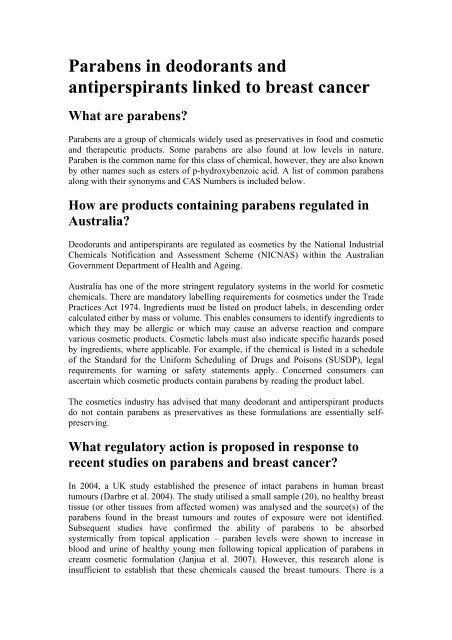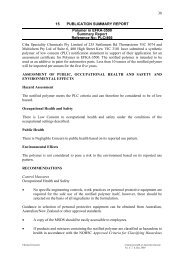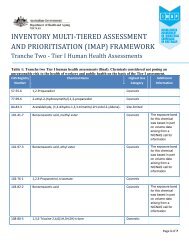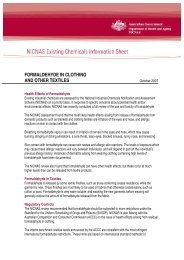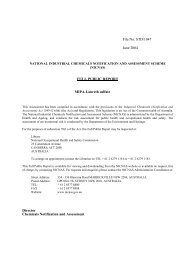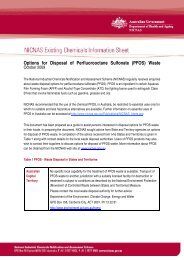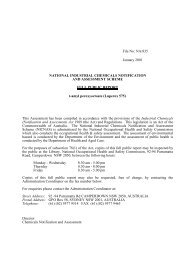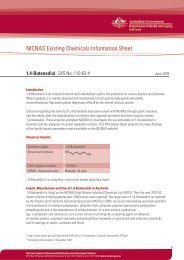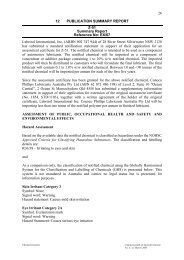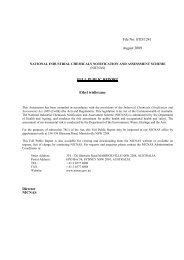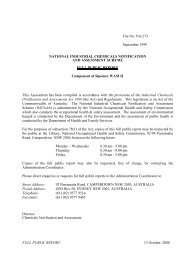Parabens in deodorants and antiperspirants linked to breast - NICNAS
Parabens in deodorants and antiperspirants linked to breast - NICNAS
Parabens in deodorants and antiperspirants linked to breast - NICNAS
Create successful ePaper yourself
Turn your PDF publications into a flip-book with our unique Google optimized e-Paper software.
<strong>Parabens</strong> <strong>in</strong> <strong>deodorants</strong> <strong>and</strong><br />
<strong>antiperspirants</strong> l<strong>in</strong>ked <strong>to</strong> <strong>breast</strong> cancer<br />
What are parabens?<br />
<strong>Parabens</strong> are a group of chemicals widely used as preservatives <strong>in</strong> food <strong>and</strong> cosmetic<br />
<strong>and</strong> therapeutic products. Some parabens are also found at low levels <strong>in</strong> nature.<br />
Paraben is the common name for this class of chemical, however, they are also known<br />
by other names such as esters of p-hydroxybenzoic acid. A list of common parabens<br />
along with their synonyms <strong>and</strong> CAS Numbers is <strong>in</strong>cluded below.<br />
How are products conta<strong>in</strong><strong>in</strong>g parabens regulated <strong>in</strong><br />
Australia?<br />
Deodorants <strong>and</strong> <strong>antiperspirants</strong> are regulated as cosmetics by the National Industrial<br />
Chemicals Notification <strong>and</strong> Assessment Scheme (<strong>NICNAS</strong>) with<strong>in</strong> the Australian<br />
Government Department of Health <strong>and</strong> Age<strong>in</strong>g.<br />
Australia has one of the more str<strong>in</strong>gent regula<strong>to</strong>ry systems <strong>in</strong> the world for cosmetic<br />
chemicals. There are m<strong>and</strong>a<strong>to</strong>ry labell<strong>in</strong>g requirements for cosmetics under the Trade<br />
Practices Act 1974. Ingredients must be listed on product labels, <strong>in</strong> descend<strong>in</strong>g order<br />
calculated either by mass or volume. This enables consumers <strong>to</strong> identify <strong>in</strong>gredients <strong>to</strong><br />
which they may be allergic or which may cause an adverse reaction <strong>and</strong> compare<br />
various cosmetic products. Cosmetic labels must also <strong>in</strong>dicate specific hazards posed<br />
by <strong>in</strong>gredients, where applicable. For example, if the chemical is listed <strong>in</strong> a schedule<br />
of the St<strong>and</strong>ard for the Uniform Schedul<strong>in</strong>g of Drugs <strong>and</strong> Poisons (SUSDP), legal<br />
requirements for warn<strong>in</strong>g or safety statements apply. Concerned consumers can<br />
ascerta<strong>in</strong> which cosmetic products conta<strong>in</strong> parabens by read<strong>in</strong>g the product label.<br />
The cosmetics <strong>in</strong>dustry has advised that many deodorant <strong>and</strong> antiperspirant products<br />
do not conta<strong>in</strong> parabens as preservatives as these formulations are essentially selfpreserv<strong>in</strong>g.<br />
What regula<strong>to</strong>ry action is proposed <strong>in</strong> response <strong>to</strong><br />
recent studies on parabens <strong>and</strong> <strong>breast</strong> cancer?<br />
In 2004, a UK study established the presence of <strong>in</strong>tact parabens <strong>in</strong> human <strong>breast</strong><br />
tumours (Darbre et al. 2004). The study utilised a small sample (20), no healthy <strong>breast</strong><br />
tissue (or other tissues from affected women) was analysed <strong>and</strong> the source(s) of the<br />
parabens found <strong>in</strong> the <strong>breast</strong> tumours <strong>and</strong> routes of exposure were not identified.<br />
Subsequent studies have confirmed the ability of parabens <strong>to</strong> be absorbed<br />
systemically from <strong>to</strong>pical application – paraben levels were shown <strong>to</strong> <strong>in</strong>crease <strong>in</strong><br />
blood <strong>and</strong> ur<strong>in</strong>e of healthy young men follow<strong>in</strong>g <strong>to</strong>pical application of parabens <strong>in</strong><br />
cream cosmetic formulation (Janjua et al. 2007). However, this research alone is<br />
<strong>in</strong>sufficient <strong>to</strong> establish that these chemicals caused the <strong>breast</strong> tumours. There is a
need for further research <strong>to</strong> establish the significance of the presence of parabens <strong>in</strong><br />
these tumours <strong>and</strong> <strong>to</strong> establish any l<strong>in</strong>k between parabens <strong>in</strong> underarm cosmetics <strong>and</strong><br />
the development of <strong>breast</strong> cancer.<br />
Data from published sources <strong>in</strong>dicate that parabens demonstrate weak oestrogenic<br />
activity <strong>in</strong> some experimental animals <strong>and</strong> that enzymes present <strong>in</strong> sk<strong>in</strong> cells <strong>and</strong><br />
subcutaneous fat cells are capable of break<strong>in</strong>g down <strong>to</strong>pically applied parabens.<br />
Follow<strong>in</strong>g analysis of all available data, <strong>NICNAS</strong> believes that further research is<br />
required before a causal l<strong>in</strong>k between parabens <strong>in</strong> cosmetic products <strong>and</strong> <strong>breast</strong> cancer<br />
can be established.<br />
<strong>Parabens</strong> <strong>in</strong> cosmetic products are considered safe <strong>to</strong> use when the products are used<br />
as directed.<br />
Common name Synonyms<br />
benzylparaben<br />
isobutylparaben<br />
Butylparaben<br />
Benzoic acid, 4-hydroxy-, phenylmethyl ester<br />
4-Hydroxybenzoate de benzyle<br />
benzyl 4-hydroxybenzoate<br />
Benzyl-4-hydroxybenzoat<br />
4-hidroxibenzoa<strong>to</strong> de bencilo<br />
Benzyl p-hydroxybenzoate<br />
benzoate, 4-hydroxy-, benzyl<br />
4-(Benzyloxycarbonyl)phenol<br />
4-Hydroxybenzoic acid benzyl ester<br />
Benzoic acid, p-hydroxy-, benzyl ester<br />
p-Hydroxybenzoic acid benzyl ester<br />
Benzoic acid, 4-hydroxy-, 2-methylpropyl ester<br />
4-Hydroxybenzoate d'isobutyle<br />
isobutyl 4-hydroxybenzoate<br />
Isobutyl-4-hydroxybenzoat 4-hidroxibenzoa<strong>to</strong> de<br />
isobutilo<br />
2-Methylpropyl p-hydroxybenzoate<br />
Benzoic acid, p-hydroxy-, isobutyl ester<br />
iso-Butyl p-hydroxybenzoate<br />
Isobutyl p-hydroxybenzoate<br />
p-Hydroxybenzoic acid isobutyl ester<br />
Benzoic acid, 4-hydroxy-, butyl ester<br />
4-Hydroxybenzoate de butyle butyl 4-hydroxybenzoate<br />
Butyl-4-hydroxybenzoat<br />
4-hidroxibenzoa<strong>to</strong> de butilo<br />
4-Hydroxybenzoic acid butyl ester<br />
4-hydroxybenzoesaeure-butylester<br />
benzoate, 4-hydroxy-, butyl<br />
p-oxybutylbenzoate<br />
4-(Bu<strong>to</strong>xycarbonyl)phenol<br />
Asep<strong>to</strong>form Butyl<br />
CAS<br />
Number<br />
94-18-8<br />
4247-02-3<br />
94-26-8
Common name Synonyms<br />
n-<br />
Propylparaben<br />
Ethylparaben<br />
Methylparaben<br />
Benzoic acid, p-hydroxy-, butyl ester<br />
Butyl p-hydroxybenzoate<br />
n-Butyl 4-hydroxybenzoate<br />
n-Butyl p-hydroxybenzoate<br />
n-Butylparabenp-Hydroxybenzoic acid butyl ester<br />
Benzoic acid, 4-hydroxy-, propyl ester<br />
4-Hydroxybenzoate de propyle propyl 4hydroxybenzoate<br />
Propyl-4-hydroxybenzoat<br />
4-hidroxibenzoa<strong>to</strong> de propilo<br />
4-Hydroxybenzoic acid propyl ester<br />
4-hydroxybenzoesaeure-propylester<br />
4-hydroxybenzoic acid propylester<br />
propyl p-hydroxybenzoate<br />
propyl paraben<br />
benzoate, 4-hydroxy-, propyl<br />
Benzoic acid, p-hydroxy-, propyl ester<br />
n-Propyl 4-hydroxybenzoate<br />
p-Hydroxybenzoic acid propyl ester<br />
p-Hydroxybenzoic acid, propyl ester<br />
p-Hydroxybenzoic propyl ester<br />
Benzoic acid, 4-hydroxy-, ethyl ester<br />
4-Hydroxybenzoate d'ethyle ethyl 4-hydroxybenzoate<br />
Ethyl-4-hydroxybenzoat<br />
4-hidroxibenzoa<strong>to</strong> de etilo<br />
4-hydroxybenzoesaeure-aethylester<br />
benzoate, 4-hydroxy-, ethyl<br />
ethylparaben<br />
ethyl parasept<br />
4-(Ethoxycarbonyl)phenol<br />
4-Carbethoxyphenol<br />
4-Hydroxybenzoic acid ethyl ester<br />
Benzoic acid, p-hydroxy-, ethyl ester<br />
Ethyl p-hydroxybenzoate<br />
p-(Ethoxycarbonyl)phenol<br />
p-Carbethoxyphenol<br />
p-Hydroxybenzoate ethyl ester<br />
p-Hydroxybenzoic acid ethyl ester<br />
Benzoic acid, 4-hydroxy-, methyl ester<br />
4-Hydroxybenzoate de methyle<br />
methyl 4-hydroxybenzoate<br />
Methyl-4-hydroxybenzoat<br />
4-Hidroxibenzoa<strong>to</strong> de metilo<br />
4-Hydroxybenzoic acid methyl ester<br />
4-hydroxybenzoesaeure-methylester<br />
benzoate<br />
CAS<br />
Number<br />
94-13-3<br />
120-47-8<br />
99-76-3
Common name Synonyms<br />
, 4-hydroxy-, methyl methyl p-hydroxybenzoate<br />
p-hydroxybenzoic acid<br />
methyl ester<br />
methyl paraben<br />
methyl ester of p-hydroxy benzoic acid<br />
4-(Carbomethoxy)phenol<br />
4-(Methoxycarbonyl)phenol<br />
Benzoic acid, p-hydroxy-, methyl ester<br />
Methylben<br />
Methylparaben<br />
p-Carbomethoxyphenol<br />
p-Methoxycarbonylphenol<br />
Source: National Chemical Inven<strong>to</strong>ries disc<br />
CAS<br />
Number<br />
Reference: Janjua NR, Frederiksen H, Skakkebæk NE, Wulf HC <strong>and</strong> Andersson A<br />
(2007) Ur<strong>in</strong>ary excretion of phthalates <strong>and</strong> paraben after repeated whole-body <strong>to</strong>pical<br />
application <strong>in</strong> humans. Intl J. Andrology, Vol 31 (2) pp 118-130.


